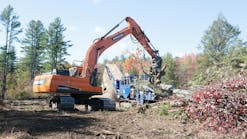After a new street is paved, a new highway built or a new bridge is erected, the motorists who subsequently travel those routes may very much appreciate the upgrade, but often won’t have a real idea of what went into the actual construction. In some cases, in fact, even experienced construction professionals may not realize exactly how certain aspects of a job were accomplished.
A great example took place during the kcICON project in Kansas City, a $245 million undertaking that included the rehabilitation of more than 4 miles of Interstates 29 and 35, as well as construction of the new Christopher S. Bond Bridge, which replaced the Paseo Bridge, which spanned the Missouri River since 1954. The Missouri Department of Transportation (MoDOT) estimated that building the road and bridge structures included in the project required 7,000 tons of steel and 50,000 cubic yards of concrete.The significant scope of the project prompted three contractors-Clarkson Construction Co., Massman Construction Co., and Kiewit Construction-to form a joint venture partnership in pursuing their bid for the job, and they were awarded the design-build contract.
The project was almost two years in the making when Massman Construction, a century-old company that has long enjoyed a reputation as one of the country’s most successful bridge builders, encountered a unique challenge in completing a critical portion of the new cable-stayed river bridge.
The bridge deck was to be composed of precast concrete panels, each weighing about 60,000 pounds. The panels, which were designed to have post-tensioning bars installed, were formed in a precast yard and hauled to the bridge site. Once the panels were placed and properly positioned, Massman was left with an 18-inch-wide by 12-inch-deep void, or trough, that would need to be filled with poured concrete in order to connect and solidify the bridge deck. The only problem was that this task could not be delayed and, therefore, would have to be accomplished in the dead of winter.
“Taking into account the cold weather concreting considerations for proper curing, we had to maintain our concrete pour at a minimum temperature of 46°F for seven consecutive days,” says Dale Helmig, project manager for Massman. “We were on a tight schedule and looking at outdoor temperatures at or below zero, so we had to find a way to keep the concrete warm.”
Massman contemplated various ways to generate the necessary heat. Although the company felt confident that they could use portable heaters to heat the top of the fresh concrete, the support beam below the bridge-which essentially was the bottom of the trough where concrete was to be poured-was constantly exposed to the elements and difficult to heat.
After some evaluation, Massman’s crew decided the only way to keep the bottom warm would be to completely enclose it. The idea was to come underneath from a barge on the river, hoist up a boxed plywood structure around the beam, and then force heated air into that enclosure. But after some number crunching, it was determined the cost of the entire setup would be excessive, particularly since it was going to be time-consuming to execute and there was no guarantee the appropriate conditions could be achieved.
Fortunately for Massman, the company connected with a local equipment dealer that had an alternative solution in the form of electric-powered concrete curing blankets from Powerblanket LLC. Unlike the radiant heat from the furnace and blower alternatives Massman had been considering, Powerblanket delivers contact heat. The blankets help concrete cure without cracking or defects by essentially sealing in the hydration that concrete naturally produces, as well as by providing additional heat to keep the concrete within a desired temperature range.
“We gave Powerblanket’s engineers the boundary conditions we had to keep the concrete pour within-at least 46 degrees at the bottom but no warmer than 82 degrees at the top,” says Helmig. “They performed the calculations and determined the appropriate blankets needed to get the job done.”
Paseo Bridge across the Mississippi River.
While standard duty blankets would have easily provided immediate heat to the top surface of the poured concrete, it was decided that they would not be adequate to heat the entire 12-inch depth due to the extreme cold affecting the bottom portion of the slab that rested on the steel support beam beneath the bridge deck. Therefore, Powerblanket recommended its Extra Hot Series EH0612 blankets instead of its standard duty model. To ensure that the blankets did not overheat the concrete, Massman requested that each of the 34 blankets they purchased be equipped with an external digital thermostat so that temperatures could be monitored constantly.
The Powerblankets used on the job had dimensions of 6 feet by 12 feet, easily exceeding the 18-inch width of the trough to be filled. The additional blanket width was utilized to preheat the precast concrete panels that formed the sides of the trough prior to the pour. The preheating process helped minimize each panel’s ability to absorb heat from the freshly poured concrete. Additionally, this would prevent the panels from experiencing too rapid of a temperature change upon placement of the new concrete, which could otherwise result in thermal cracking and compromised structural integrity.
Using portable generators and junction boxes to supply power to the 120-V electric blankets, Massman initiated the weeklong concrete cure. In addition to relying on the blankets’ external thermostats, crew members used probes to take temperature readings several times daily to ensure that the engineering specifications were being properly met and maintained for the full seven-day period-during which the outdoor air temperature hit a low of minus-5 degrees.
“It was awfully cold, but the blankets did their job keeping the concrete temperatures within spec,” says Helmig. “We achieved the PSI levels we had targeted, and it turned out to be a successful operation. We didn’t have the time to wait out the winter for the temperatures to become more moderate. The Powerblankets certainly played an important role in keeping us on schedule and not having to postpone the pour.”
Massman and the rest of the Paseo Corridor Constructors partnership kept the strong momentum of its significant winter accomplishment going, as the Christopher S. Bond Bridge and all Interstate 29 and 35 lanes and ramps opened well ahead of the originally scheduled deadline.
To the 102,000 motorists who travel the Paseo Corridor each day, there’s little chance that challenging 18-inch stretch of concrete will ever draw their attention. Decades from now, contractors performing bridge maintenance probably won’t give it a second thought either. Only the workers who achieved the pour in frigid conditions will know that closing that little gap was no ordinary construction situation, but nonetheless one where the right solution made all the difference.





